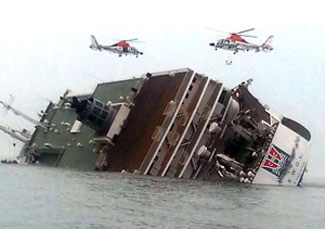More than 290 people were killed when a severely overloaded South Korean ferry sank in April. The captain and three officers were charged with murder.
The ro-ro passenger ferry Sewol, carrying 476 passengers and crew, listed 60°, capsized and sank on the morning of April 16. As of late June, 11 people were still missing. Two divers died during the search for bodies in the sunken ferry.
The 6,825-ton Sewol was traveling from Incheon, South Korea, to the holiday island of Jeju, a voyage of over 13 hours. Passengers included 325 students and teachers on a high school trip.
The ferry was 481 feet long and 72 feet wide with a capacity of 921 passengers. The vessel had a capacity for 180 vehicles and 152 containers. It was built in 1994 at a Japanese shipyard.
In the wake of the sinking, there have been multiple investigations and arrests conducted by local and national agencies in South Korea. There is a criminal investigation into allegations of embezzlement by the owners of the ferry. A company executive is charged with causing the deaths through negligence.
Another probe is looking into whether the South Korean Coast Guard properly responded to the sinking. The nation’s president even proposed that the Coast Guard be disbanded. The Korean Register of Shipping faces allegations that the classification society failed to properly evaluate and inspect the safety of changes made during a retrofit of Sewol in 2012-2013 at a South Korean shipyard.
On May 15, the Incheon District Prosecutors’ Office charged the captain, chief engineer and first and second mates with homicide through abandonment, for failing to come to the aid of passengers. In addition, 11 crew were charged with abandoning the ferry and violating safety procedures. The captain and most crewmembers abandoned ship while hundreds of passengers were still on board. Four employees who handled cargo on Sewol were charged with accidental homicide.
Sewol’s captain did not order the evacuation of passengers and crew did not follow emergency procedures, officials have said. In addition, only one of the vessel’s 46 life rafts was deployed.
Sewol left Incheon on April 15 at about 2100, four hours later than scheduled due to fog. At 0849 on April 16, Sewol made a starboard turn of 15°. At that point, the captain was not on the bridge, according to Hyung-jun Kim, a spokesman for the Korean Coast Guard. The third mate was in charge at that time. The vessel began to list after the sharp turn.
At 0852 a student called a Korean national emergency number and said he thought the ferry was sinking. At 0853 Sewol lost engine power and drifted north with the tide, according to HIS Maritime’s AISLive. At 0855, Sewol sent a distress signal to Jeju Vessel Traffic Services. At 0900, an announcement was made to passengers to put on life jackets and stay in their rooms. This announcement was repeated several times. However, the captain never issued an evacuation order, according to Kim. An unidentified female crewmember issued an evacuation order, but at that point it was too late.
Also at 0900, Sewol told Jeju VTS that containers on the deck had fallen over. Jeju VTS advised Sewol that passengers should put on life jackets in case they have to abandon ship.
At 0906, communications were switched to Jindo Vessel Traffic Services, which was closer. At 0911, the vessel was listing 45° to port, according to AISLive. At 0914 Jindo VTS asked if passengers were able to escape. Sewol responded that it was impossible because the list was so severe.
At 0917 the vessel was listing 50° to port. Sewol told Jindo VTS that crew could not move and were stuck on the bridge.
At 0923 Sewol said it could no longer broadcast to passengers. Jindo VTS told Sewol at 0924 to send someone to tell passengers to put on life jackets or thick clothes. Sewol asked Jindo VTS that if passengers get out of the ship, would they be rescued immediately. Jindo VTS told Sewol it is up to the captain to issue an evacuation order.
At about 0928, the first South Korean Coast Guard helicopter arrived. At about 0930 Sewol was listing 60°. Sewol’s transmission with Jindo VTS ended at 0938. Sewol capsized at about 1118.
Several factors contributed to Sewol’s sinking, government officials said. Between October 2012 and February 2013, the ferry’s owner, Chonghaejin Marine Co., added cabins to the third, fourth and fifth decks making the vessel top-heavy.
On its final voyage, the ferry was carrying about 3,600 tons of cargo when it was licensed for 987 tons, according to a statement from the Maritime Industry and Technology Division of the Korean Ministry of Maritime Affairs and Fisheries. The vessel was carrying only about 500 tons of water ballast, when it was required to have 2,020 tons.
“When the vessel turned to starboard for the next course, she lost balance, even though the sea condition was not rough,” the agency said. The cargo was not secured properly. Sewol was carrying 124 cars, 57 trucks, four kinds of heavy equipment and several containers.
An off-duty captain urged company officials to stop overloading freight, according to post-accident interviews. In addition, a 42-year-old first mate has said he brought up the issue of overloading on several occasions. Overloading the ferry appears to have been a routine practice, crewmembers stated.

